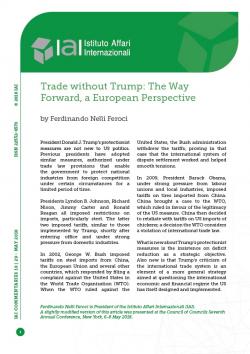Trade without Trump: The Way Forward, a European Perspective
Trade without Trump: The Way Forward, a European Perspective
Ferdinando Nelli Feroci*
President Donald J. Trump’s protectionist measures are not new to US politics. Previous presidents have adopted similar measures, authorized under trade law provisions that enable the government to protect national industries from foreign competition under certain circumstances for a limited period of time.
Presidents Lyndon B. Johnson, Richard Nixon, Jimmy Carter and Ronald Reagan all imposed restrictions on imports, particularly steel. The latter two imposed tariffs, similar to those implemented by Trump, shortly after entering office and under strong pressure from domestic industries.
In 2002, George W. Bush imposed tariffs on steel imports from China, the European Union and several other countries, which responded by filing a complaint against the United States in the World Trade Organization (WTO). When the WTO ruled against the United States, the Bush administration withdrew the tariffs, proving in that case that the international system of dispute settlement worked and helped smooth tensions.
In 2009, President Barack Obama, under strong pressure from labour unions and local industries, imposed tariffs on tires imported from China. China brought a case to the WTO, which ruled in favour of the legitimacy of the US measure. China then decided to retaliate with tariffs on US imports of chickens; a decision the WTO considers a violation of international trade law.
What is new about Trump’s protectionist measures is the insistence on deficit reduction as a strategic objective. Also new is that Trump’s criticism of the international trade system is an element of a more general strategy aimed at questioning the international economic and financial regime the US has itself designed and implemented.
It is as if the system of rules and institutions that, under US leadership, had shaped the institutional infrastructure of international trade, investment and finance no longer corresponds to US national and strategic interests. Globalization in this context is perceived more as a threat than an opportunity; global governance does not rank among the priorities for the United States; and only bilateral deals, based on a transactional calculation of their direct and immediate benefits for the United States are considered valuable means to protect the US national interest.
Such rhetoric and approaches, announced and amplified during the electoral campaign, contributed to Trump’s election. Several concrete measures have since fulfilled these promises: the withdrawal from the Trans-Pacific Partnership, the request to renegotiate the North American Free Trade Agreement (NAFTA), the end of any concrete prospect for the Transatlantic Trade and Investment Partnership (TTIP) and the adoption (or the threat to adopt) of tariffs and other limitations on imports from countries considered unfair competitors of the United States.
In Europe, awareness that globalization should be managed and that some of the harmful consequences of globalization should be corrected is growing. Perceptions of an unregulated global economy and an unfair trading regime are also fuelling scepticism and frustration across Europe. This is demonstrated not only by the success in most European countries of populist and nationalist parties but also by a new political narrative adopted by mainstream political parties and governments that emphasizes the need to protect citizens from the detriments of globalization.
Nevertheless, European governments and EU institutions remain generally convinced that European interests are better safeguarded by an international order based on recognized rules and legitimate and efficient international institutions. Europe, a highly export-oriented economy, has an interest in defending trade liberalization and an open trading system.
The EU will therefore continue to invest in trade agreements and also defend a multilateral system of free (and fair) trade, under the auspices of WTO rules and principles. It will thus likely continue to negotiate and conclude free trade agreements with third countries or groups of countries. The process of ratifying the Comprehensive Economic and Trade Agreement (CETA) with Canada will go on. Soon the free trade agreements and the EU-Japan Economic Partnership Agreement will be signed. Negotiations for the conclusion of a free trade agreement with Mercosur and with a number of Association of Southeast Asian Nations member countries will continue with the hope of a conclusion within a reasonable deadline.
Last but not least, the EU will soon begin the most ambitious trade agreement ever negotiated. Due to the UK’s refusal to participate in the EU single market, the only available instrument to regulate future relations will be a new and innovative comprehensive free trade agreement (which will have to take into account all the complexities deriving from the special status of the UK as a former EU member).
So far, evidence shows that Trump’s recent protectionist measures (on washing machines and solar panels in January, on steel and aluminium in March and the pending threat on some 1,300 industrial and technological products) primarily target China, given that Beijing is mostly responsible for the US’s trade deficit in goods (a total of 811.2 billion dollars in 2017, of which 375.2 billion is with China alone).[1]
Protectionist measures against Europe have only been threatened, not adopted. The EU is negotiating a permanent exemption for European imports of steel and aluminium. The Trump administration is likely to decide on this request by the beginning of June,[2] but it is unclear what sort of compensation the United States requires to grant such an exemption.
Even the prospect of a trade war or the risk of a vicious circle of retaliatory and counter-retaliatory measures between the United States and China threatens the European economy. A continuing spiral of tariffs and counter-tariffs between the United States and China could affect trade flows between China and the EU (as a consequence of a diversion of China’s exports from the United States to the EU markets). It could also have more systemic consequences on global trade and on its governance, risking a disruption of the post-war trading system.
In a situation characterized by a potential trade conflict between its two main trading partners, the EU should avoid being caught in the trap of having to choose between the United States and China.
It should therefore respond to a new US offensive on trade with an articulate strategy that would include the following elements:
First, the EU should reaffirm its position of principle against threatened tariffs on EU exports to the United States and react to the measures announced by the Trump administration by agreeing (as it has already done) on a list of US products to which an import duty would be imposed in retaliation. At the same time, it should challenge the legitimacy of US measures at the WTO. The first objective should be to obtain a permanent exemption from tariffs on steel and aluminium (and possibly on further US protectionist measures).
Second, the EU should consider the arguments used by the Trump administration to impose tariffs (hopefully only on China’s exports), with the objective of verifying whether it would be possible to accommodate at least some of the complaints within the existing (or reformed) rules of GATT and the WTO. In fact, the EU and the United States share an interest in pressing China to encourage self-restraint on unfair trading practices. The EU has a converging interest with the United States in obtaining better access to China’s internal market, a reduction of nontariff and regulatory barriers, better protection of intellectual property rights, a reduction of the role of the state in the economy, a decrease in public subsidies to local industries and transparency and respect of the rule of law for foreign investments in China.
Third, the EU should not only stick to its agenda of trade liberalization but also promote an initiative, together with its major trading partners, to reinforce, and where necessary, to modernize, the international trade regime based on rules and institutions such as WTO (recognizing that if WTO has lost its appeal as a negotiating body, it still maintains its value at least as a regulatory body and as a settlement of disputes system). Reform and modernization of the international trading system should be pursued in the most inclusive manner. Here, the biggest challenge would be to convince the Trump administration of the value of a regulated international trading regime.
Fourth, in the context of a reform of the trade regime, the EU should promote an initiative to reconcile the reality of the growing number of intra- and inter-regional free trade agreements with the more universal principles that inspire WTO rules and procedures. As recently demonstrated by the agreement reached by forty-four African states on 21 March in Kigali, Rwanda, to create an African Continental Free Trade Area, and as confirmed by the failure of the WTO Doha Development Round, these regional agreements are at this stage the most promising instruments to promote trade liberalization. Serious efforts should however be deployed to avoid increasing fragmentation of the international trading system, which could undermine the credibility and effectiveness of multilateral trade rules and practices.
Fifth, the EU should also reform its own trade policy by increasing the transparency and democratic legitimacy of its negotiating procedures if it wants to avoid rejection of trade liberalization by domestic public opinion. The recent difficulties encountered in the ratification process of important trade agreements suggests the need for various actors to be better involved in the early stages of the negotiations leading to the conclusion of such agreements.
In conclusion, the EU should stand up to Trump on trade, and retaliate if necessary against restrictions on EU exports to the US. But it should also stick to its trade liberalization agenda; insist on the need to safeguard a rules-based international trade regime and its institutions; and at the same time also engage other stakeholders in a concerted action aimed at reforming and modernizing this regime.
* Ferdinando Nelli Feroci is President of the Istituto Affari Internazionali (IAI).
A slightly modified version of this article was presented at the Council of Councils Seventh Annual Conference, New York, 6-8 May 2018.
[1] US Bureau of Economic Analysis, 2017 Trade Gap is $568.4 Billion, 7 March 2018, https://www.bea.gov/newsreleases/international/trade/2018/pdf/trad0118annual_fax.pdf; US Census Bureau website, Trade in Goods with China, https://www.census.gov/foreign-trade/balance/c5700.html.
[2] Megan Cassella, “Trump Grants EU Extra Month of Relief from Steel Tariffs”, in Politico, 1 May 2018, https://www.politico.eu/article/donald-trump-grants-key-allies-extra-month-of-relief-from-steel-aluminum-tariffs.
-
Details
Rome, IAI, May 2018, 4 p. -
In:
-
Issue
18|29



